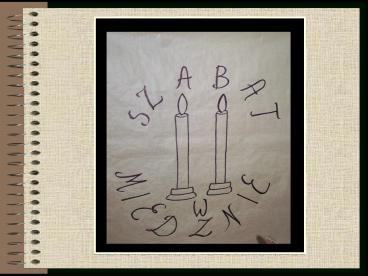Prezentacja programu PowerPoint - PowerPoint PPT Presentation
Title:
Prezentacja programu PowerPoint
Description:
Friday had come. The sun was gently beginning to peek into the homes of the inhabitants of Miedzna. The households of Ch. Celnikow, A. Goldsztejn, N. Szmklerz ... – PowerPoint PPT presentation
Number of Views:38
Avg rating:3.0/5.0
Title: Prezentacja programu PowerPoint
1
(No Transcript)
2
Friday had come. The sun was gently beginning to
peek into the homes of the inhabitants of
Miedzna.
3
The households of Ch. Celnikow, A. Goldsztejn, N.
Szmklerz , Zylbernagiel as well as other Jews
living in our town were beginning to stir. Women
brought out the grocery products gathered for the
occasion and were begining to prepare the festive
dishes. A large pot was filled with groats,
beans, beef and potatoes. Houses and streets
filled with the scent of cholent which would only
acquire its final taste in the afternoon.
4
Jewish women poured flour onto their pastry
boards, adding eggs, fat and other indispensable
ingredients, and began to knead the dough for
challah.
Having braided the dough strands by hand they
then made their way to the bakery on the corner
of the street leading to the nearby town of
Orzeszówka, where the large and tasty challas
were baked in the great stove. The great stove at
the bakery was also where the cholent would be
left to simmer, awaiting the Sabbath meal.
Herring, purchased by Jewish women in nearby town
of Wegrowo, were also prepared.
5
The whole household prepared for the celebration.
Homes were beginning to take on a festive look.
Rugs were beaten and arranged, rooms cleaned,
beds made. The women then put out the fire in
the stove. Mothers made sure children were clean,
groomed and dressed in fresh clothing.
6
The table was set and candles placed upon it.
7
Every member of the family took his or her seat
around the festive table.
8
The waiting began. The sun was beginning to set.
9
At the appropriate moment, the mother lit two
candles placed in two separate candlesticks.
She then proceeded to make three movements
towards herself with both her hands over the
flame, cover her eyes and speak the blessing.
10
She then uncovered her eyes and looked towards
the lit candles. From that moment on the women
were considered to have begun the Sabbath and
refrained from perfoming prohibited tasks. The
words Shabbat Shalom were then spoken.
11
The cholent, left to simmer in the bakery stove,
was brought by the Shabbat goy, who received
money for his services. After the candles were
lit, it was time to go to the local synagogue, a
one-floor wooden building on what today is
Bednarska street. Most of the Jews did not have
far to go since most of them lived along what
today are Orzeszkowej and Nadstawna streets.
12
It was mainly the men that attended the
synagogue. The next part of the Sabbath evening
began after their return. Traditional songs were
sung by those assembled at the table.
13
Children impatiently waited to be blessed and
addressed by their father.
14
After the singing, the father spoke the blessing,
holding a cup of wine over the table. When the
prayer was finished and the wine poured and
consumed, the people gathered at the Sabbath
table cleansed their hands.
15
Next, the head of the household marked out the
place where the challah would be divided from
with a knife. Once it had been lifted up and
blessed, it was to be dipped in salt before being
consumed.
16
The challah was then divided and everyone ate
their part.
17
The supper then began at last. The dishes
prepared earlier were eaten, song and
conversation filled the air. It was a time to be
with ones family.
18
In Miedzna, trade ceased and shops closed with
the coming of Shabbat. Catholics passing in the
street could see candlelight in their neighbors
windows. Everyone remembered that when God had
finished his creation on the sixth day, he rested
on the seventh day, having accomplished his task.
Then God blessed the seventh day and sanctified
it, because in it He rested from all His work
which God had created and made.(Genesis 1,1-3).
19
Information on Shabbat celebrations in Miedzna
based on conversations with Mrs. Henryka Rusjan,
collected and collated by Marta Salach,
Magdalena Golos, Marlena Derlicka, Justyna
Rusjan, Kinga Wakulicz, Eliza Golebiewska.
Supervisors Marzena Orzel and Anna
Tulwin-Salach
Tadeusz Kosciuszko Elementary School in
Miedzna November 2008































